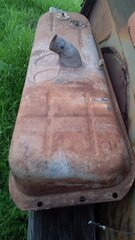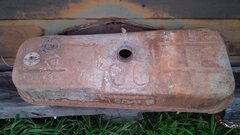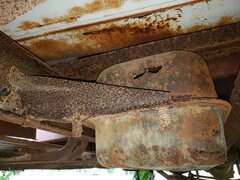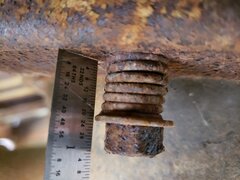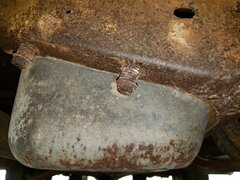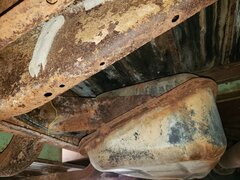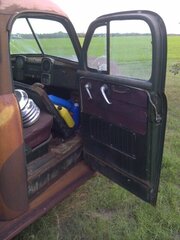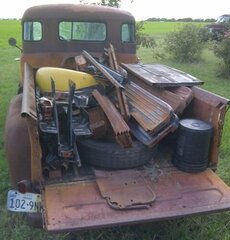-
Posts
6,965 -
Joined
-
Last visited
-
Days Won
72
Content Type
Links Directory
Profiles
Articles
Forums
Downloads
Store
Gallery
Blogs
Events
Everything posted by JBNeal
-
While removing photobucket pics from posts on here and replacing them with pictures stored in gallery albums, I noticed on several threads issues with mounting fuel tanks, with the mounting hardware, with tank to cab seals, and with replacing with the Tanks, Inc. W-series reproduction as it is quite a bit cheaper than the B-series reproduction or using the Gas Tank Renu service. So I consulted the parts manual, which raised more questions as to what that book said and what contributors on here said (including myself). Now that I have a better understanding of what's going on, I figured that I should document my findings for future information searches done on this subject so that there is little ambiguity on this subject. Special thanks to Brent for verifying the B-4-D-126 tank mounting ? According to the factory parts manual, there are several variations on fuel tanks for B-series trucks, but I'm only going to focus on B, C, and D express and chassis cab models. Panels, chassis and cowl, and export models have different part numbers than the express and chassis cab models, and I do not know what the differences are other than that. Basically, there are 4 different rear mounting brackets used on 2 different tanks with 5 different mounting configurations for the 9 different frame designs. The parts manual, as usual, only shows one configuration (B-1) as a general guide for parts replacement. FRONT MOUNT On B-1, B-2, and B-3 models, the front of the fuel tank mounts to the crossmember, with bolts threading into weldnuts on the fuel tank. Shown is a fix that I did when the weldnuts stripped out and/or broke off, leaving just a hole in the tank mounting flange to run a bolt through before the tank went off to be Renu'd. additional information - B-series fuel tank comparison On B-4 models, the frame and fuel tank were redesigned so that the mounting bolts with the frame flex springs were located on the front of the tank. These springs are slightly different than the rear springs used on earlier models and have different part numbers in the parts manual. However, the parts manual appears to have an error that lists the bolt spacer as 15/16", when these appear to be somewhat shorter. But this a minor issue that can be dealt with at any well stocked hardware store or an online source if replacements are required. REAR MOUNT On B-1 and early B-2 models with 108" and 126" wheelbase, mounting bracket 589572 is used with frame flex springs. On later B-2 and all B-3 models with 108" and 126" wheelbase, mounting bracket 1269979 is used with frame flex springs, as there was a change to the frame design. On B-4 models with 108" and 126" wheelbase, the fuel tank was mounted directly to the crossmember. The parts manual notes that mounting bracket 1269979 is used, but I believe this to be in error as the profiles do not match up. On B-1, B-2, and B-3 models with 116" wheelbase, mounting bracket 589571 is used with frame flex springs. (yellow line added to highlight bracket profile at frame) On B-4 models with 116" wheelbase, mounting bracket 1393998 is used. (yellow line added to highlight bracket profile at frame) Note the two larger holes in the foreground crossmember; these are the mounting holes that are used on the 108" and 126" frames, as this crossmember is located closer to the transmission. Tanks, Inc. has offered their W-series replacement tank since about 2012, and in recent years has provided some support with making this work in the B-series. moparpro has recently offered a replacement B-series tank that is based on the original design, but apparently with modern metal surface treatments to resist oxidation. There has been some debate about the installation of frame flex springs, both in usage and material composition. Modern zinc plating alternatives are cost effective improvements over the original unplated springs and hardware; deviation from that is a personal choice as performance gains here can be negligible period. Removing the springs can be done if truck is under light duty on improved roads, but I have a parts truck without these springs and that metal tank has an oil-canned surface from presumably a rough service life...skip this little design element at your own peril. Sealing the cab at the tank filler neck took several forms in the B-series, with 3 part numbers listed in the parts manual. B-1s used a foam rubber piece on top of the tank; early B-2s used a different style; and later B-2s, B-3s, and B-4s used a simple piece of rubber over the filler neck inside the cab. Since few people will see this detail, use whatever remedy you feel comfortable with to keep out the dust and critters, I won't tell the nitpickers
-
- 3
-

-

-
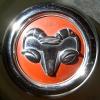
Helicoils Repaired My Carburetor
JBNeal replied to Jocko_51_B3B's topic in Mopar Flathead Truck Forum
them fillister head screws are kinda specialized these days...somebody like Carburetor Specialist might be able to help out if ya want that original look -
My guess is that was a rebuild tag, I've seen them mounted there, above the generator, and behind the starter.
-
additional information - Links to Build Threads
-
From the album: 1953 B-4-B-116 Spring Special
-
From the album: 1953 B-4-B-116 Spring Special
-
From the album: 1953 B-4-B-116 Spring Special
-
correct, use of cutting oil while using a cutting die is good practice.
-
That buggy looks purty good (except for the spaghetti under the hood), I also vote for getting it going with the flathead as it has a certain novelty wow factor. These old trucks fall into the basic transportation category in many ways...want a cupholder? use your legs
-
Links Directory updated with CTC Auto Ranch, TCP Global, Carburetor Specialist, and Brad's NOS Parts
-
As far as I know, vacuum advance for the B-series was only on 1/2 and 3/4 tons. The larger trucks were treated as workhorses that didn't need speed as much as torque to move a load. This means the engines were operated under load near peak of the power band a majority of the time, when vacuum is mostly near its lowest. So as a cost savings, vacuum advance was not included on truck flatheads if its performance improvements were negligible. As a reminder, these trucks pre-date the interstate highway system, and the best improved highways had posted speed limits under 60 mph, so the larger trucks were not the gear-jammin' diesel-burning speed demons that menace are at work on interstate highways today. The flathead trucks were geared so they could make a run at a hill, not flatten it
-
The trucks had 1/0 cable, not sure why those flatheads had this other than to deal with extreme environmental conditions. In hot starting conditions where ambient temperatures are above 100°F, I noticed a slight decrease in starter speed by sound, no doubt that a smaller gauge cable would have caused the starter speed to drag further with the increased impedence. Also, I've mentioned many times that Marvel Mystery Oil counteracts the evaporative effects of ethanol in modern gasoline blends, keeping 87 octane fresh for months for quick startups after lengthy equipment idle periods. additional information - flathead starter performance upgrade
-
I've seen both the plastic and chrome and kinda figured usage was driven by a combination of parts availability and cost savings. These details aren't explicitly listed on the build cards, so who knows how this was optioned out at the factory. The B-1 / B-2 escutcheons are a different size so even though they will fit on the later doors, they'll be mismatched with the B-3 / B-4 door handles. additional information - B-3 door escutcheons (chrome) additional information - B-4 door escutcheons (plastic)
-
From the album: 1953 B-4-B-116 Spring Special
-
From the album: 1953 B-4-B-116 Spring Special
-

How Many Pilot House Trucks Have Survived?
JBNeal replied to Bradley S.'s topic in Mopar Flathead Truck Forum
additional information - B-1 Fire Engine -
additional information - B-series (48-52) tank reproduction
-
additional information - B-1 horn button assembly
-
"oh hey I was looking for that the other day" gets said a lot in my neck of the woods
-
additional information - Burton L Norton distributor repair when I talked to BLN, they told me about the limitations of testing a distributor in an engine, and how they used a Sun testing machine to accurately refurbish distributors. On one of my distributors that I sent them on a truck that had been parked for decades, the springs had oxidized and no longer had the same K-value. They replaced springs with new, cleaned up and lubricated the mechanical advance, replaced the vacuum advance, etc and adjusted to specs...those flatheads came alive with that investment.
-
At one time, Chrysler recommended replacing oxygen sensors every 60k miles, and I read articles about how 02 sensor sensitivity declined over time, resulting in power loss, reduced fuel economy, and fouled catalytic converter. Other sensor inputs to the ECM could suffer the same fate with age as material degradation could lead to inaccurate readings. Relays may stick, but solid state electronics can have sealing epoxy fractures that allow moisture infiltration. So it might be worth the peace of mind to update input sensors so that a known baseline for engine performance is established. A refurbished ECM might be worth the investment, if they are even available. A sorta cautionary tale is what I dealt with on my 1992 John Deere 425 that is not fuel injected but has a logic circuit with sensor inputs. When it was about 17 yrs old, it would randomly shut down...hot, cold, not so hot, dry weather, wet weather, smooth or rough acreage, didn't matter...it could run for weeks, then have fits for days...I did all the tests, everything was to specifications, but the random shutdowns persisted for another 4 yrs...maddening...eventually I realized that the 3 connected safety switches (seat, PTO, park brake) could have an internal dithering issue because of their age, so I replaced all of them...problem solved. So with aging components and computer control, random problems can be very difficult to identify, no matter the size of the machine.
-
additional information - speedometer adapter


